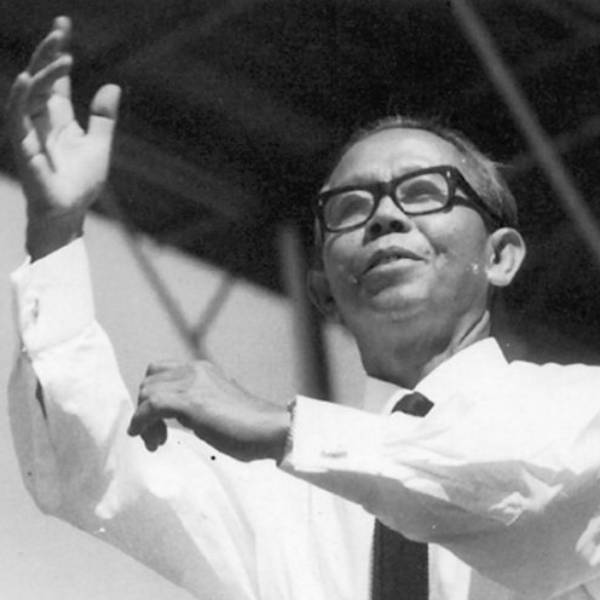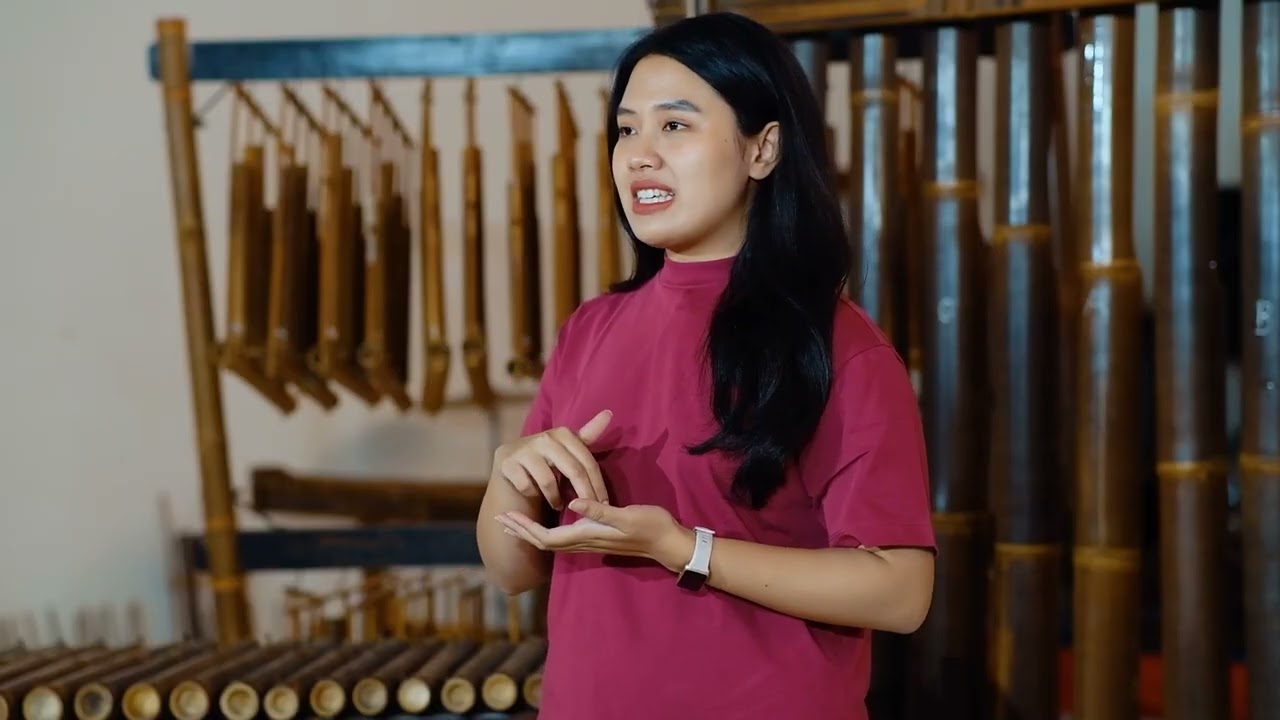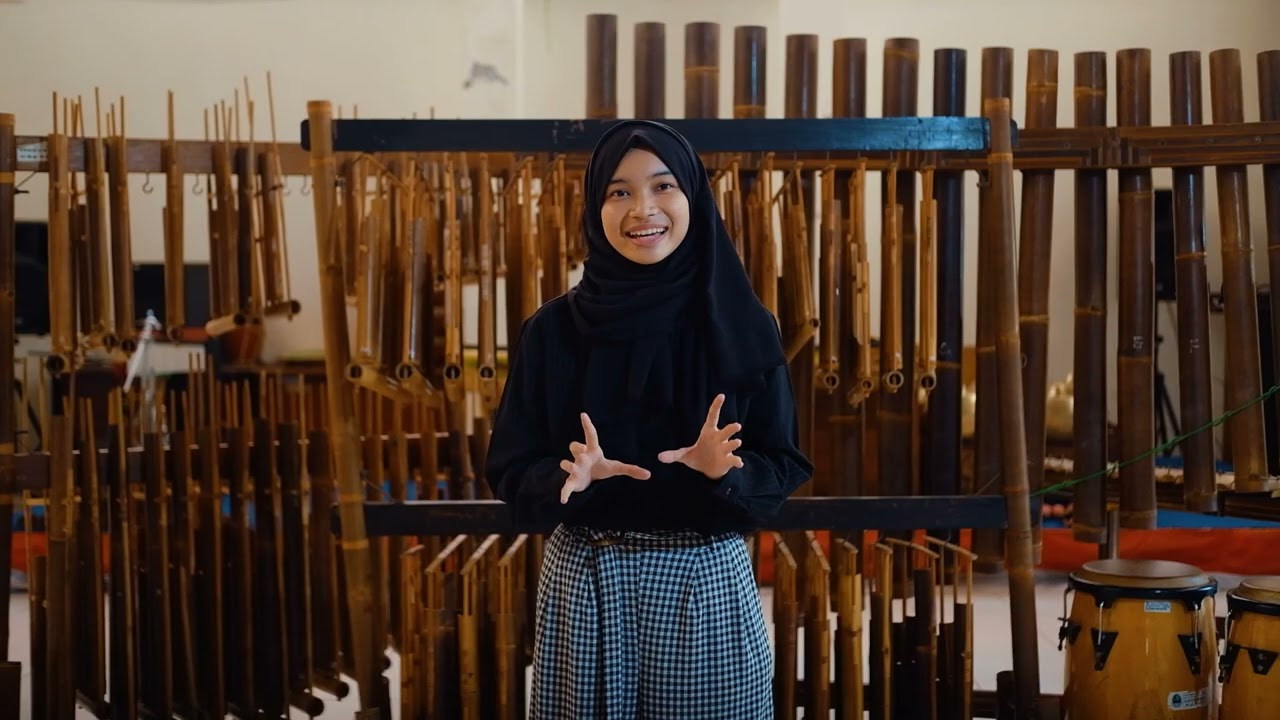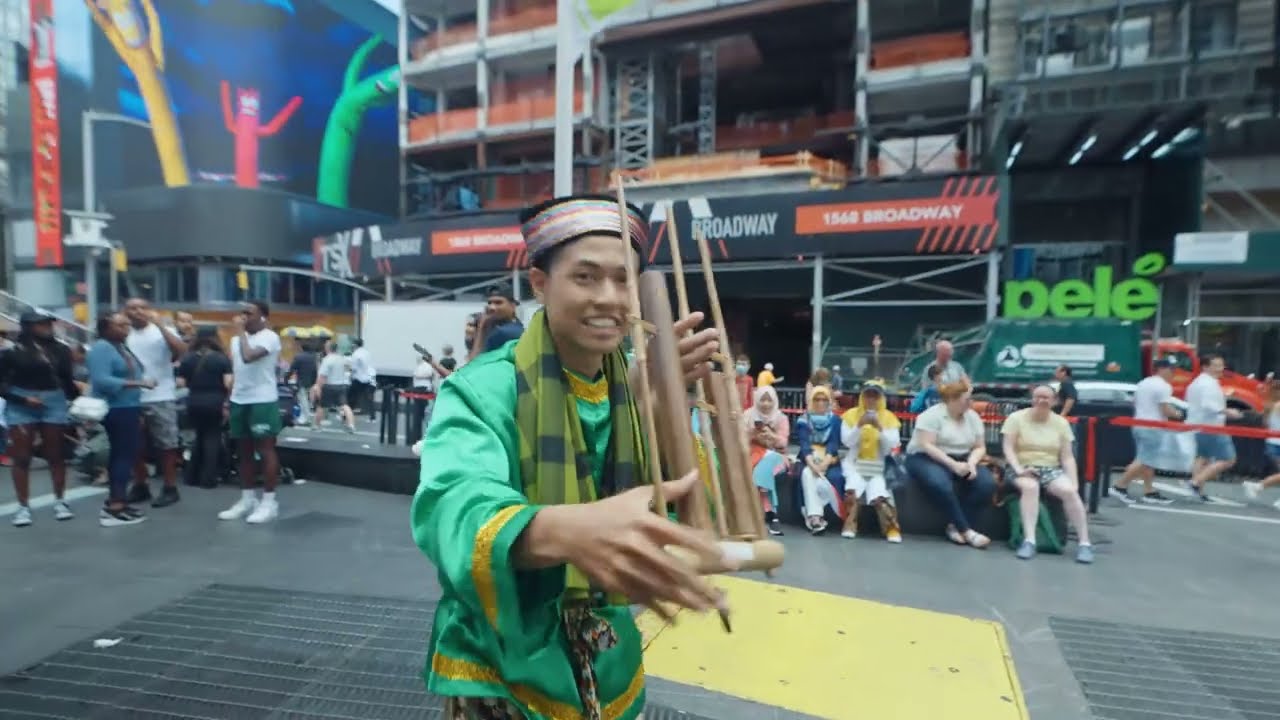The History of Angklung
Angklung comes from the Sundanese "angkleung-angkleungan", meaning the movement of the instrument player (angklung) and the "klung" sound it produces.
Angklung is a musical instrument whose name has an etymological origin in the words "angka" which means tone, and "lung" which means fraction. Therefore, the angklung is a pitch fractions instrument. A single angklung can produce only one pitch fractions, so a collection of angklungs is needed to play the instrument with vocals.
The angklung is a musical instrument made of two or more bamboo sticks in varying sizes based on the pitch. The shape of Angklung is similar to the shape of musical instrument Calung.
The basic materials for Angklung are typically black bamboo (awi wulung) and ater bamboo (awi temen), both with a whitish-yellow color when dried. The bamboo tubes produce each pitch by vibrating in blade form, with smaller tubes emitting high notes and larger ones producing low notes.
There is no definitive evidence pinpointing the exact period of angklung's appearance, though it is widely believed that its crude form had been utilized in the Neolithic culture which flourished in the archipelago before the modern era began. As such, angklung holds a significant role as one of the pre-Hindu relics in the Nusantara culture. According to Dr. Groneman, the presence of the Angklung in the archipelago can be traced back to the pre-Hindu period. In addition, as noted in Jaap Kunst's Music in Java, angklung is also documented in South Sumatra and Kalimantan.
Records indicate that Angklung's origins can be traced back to the Sundanese Kingdom, which existed from the 12th to 16th centuries. The creation of bamboo music, including angklung, was rooted in the Sundanese farming community's perspective, which relied on rice (paré) as their primary crop. This led to the myth that Nyai Sri Pohaci is the symbolic representation of the life-giving Goddess of Rice (hirup-hurip). The Badui community, considered to be the remaining descendants of the original Sundanese people, perform angklung as a part of their rice sowing ritual. The Angklung Gubrag has a history of more than 400 years and is played in Jasinga, Bogor. Its development is linked to the rice-planting ritual, as angklung was used to attract Dewi Sri to the earth, resulting in bountiful rice harvests.
One function of the angklung, known to the Sundanese community since the time of the Sundanese Kingdom, was to boost morale during battle. The angklung's function as a morale booster for the community continued into the colonial era, which led to the Dutch East Indies government banning its public use; however, the ban resulted in the angklung gaining popularity and becoming a children's instrument only.
Furthermore, the songs presented as offerings to Dewi Sri are accompanied by the sound of a drum made of bamboo sticks and packaged in a straightforward manner, ultimately constituting the Angklung, a bamboo musical instrument that we recognize today.
Angklung playing is also introduced during the Pesta Panen and Seren Taun. When performing angklung in connection with rice ceremonies, this art becomes a spectacle of procession in nature, even in some places accompanied by rengkong (an art that presents the typical sounds of playing bamboo piculans), dongdang (rice carrying equipment) and jampana (carrying food) etc.
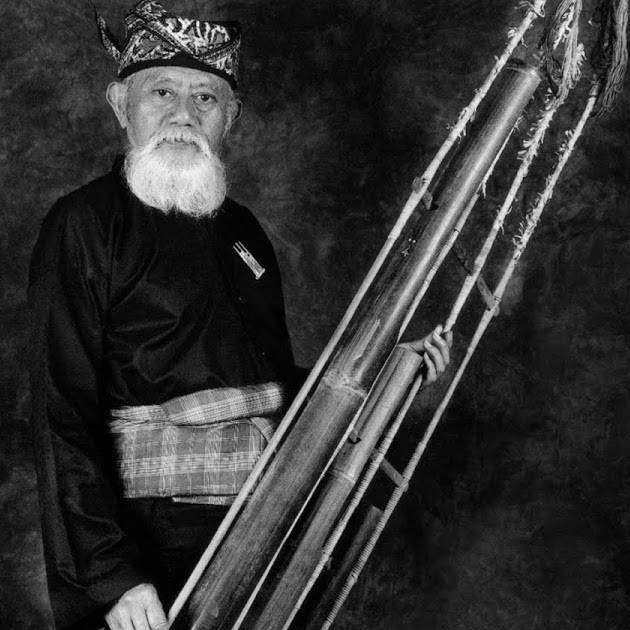
Udjo Ngalagena
Throughout its development, the Angklung underwent extensive growth and distribution across Java, and subsequently to Kalimantan and Sumatra. A historical record from 1908 documents a cultural mission from Indonesia to Thailand, where the distribution of the Angklung has led to the further spread of this musical game.
In 1938, Daeng Soetigna created Angklung diatonic, which was previously pentatonic, as a teaching tool to help his students learn music easily and comfortably. Since then, Angklung diatonic has been recognized by the Indonesian people.
Since 1966, Udjo Ngalagena, an angklung pioneer who developed playing techniques based on Pelag (a three-tone sequencing system), Salendro (a five-tone sequencing system) and Madenda (a barrel resulting from the splitting of the salendro barrel), began teaching angklung to many people through various communities.
- ANGKLUNG - Disdik Purwakarta:
http://disdik.purwakartakab.go.id/berita/detail/angklung?/berita/detail/angklung
- Angklung: Origins of Angklung - Wikipedia Indonesian language:
https://id.wikipedia.org/wiki/Angklung
- History of West Java's Bamboo Musical Instrument, Angklung - Kemdikbud Indonesian language:
https://kebudayaan.kemdikbud.go.id/ditwdb/sejarah-alat-musik-bambu-asal-jawa-barat-angklung/
- The History of Angklung, a Global Traditional Musical Instrument - IDN Times Indonesian language:
https://www.idntimes.com/science/discovery/laili-zain-damaika-1/sejarah-angklung-1
- How to play Angklung, its history and types - Detik.com Indonesian language:
https://www.detik.com/edu/detikpedia/d-6635426/cara-memainkan-angklung-sejarah-dan-jenisnya#:~:text=di%20bawah%20ini.-,Sejarah%20Angklung,Dewi%20Sri%20(dewi%20padi).
- How to play Angklung, its history and types - Sindonews.com Indonesian language:
https://nasional.sindonews.com/read/942725/15/sejarah-angklung-alat-musik-tradisional-indonesia-yang-jadi-warisan-dunia-1668557475
- Commemorating World Angklung Day on November 16, Here's the History to How to Play It - Merdeka.com Indonesian language:
http://www.merdeka.com/trending/memperingati-hari-angklung-sedunia-16-november-ini-sejarah-hingga-cara-memainkannya-kln.html
- Bandung is the City of Angklung, Here's a Brief History and Types - Bandung.go.id Indonesian language:
https://www.bandung.go.id/news/read/6437/bandung-kota-angklung-ini-sejarah-singkat-dan-jenisnya
- Inventor and creator of Angklung musical instrument:
https://biografi-penemu-terkenal-dunia.blogspot.com/2016/05/penemu-dan-pencipta-alat-musik-angklung.html
Types of Angklung
Angklung Kanekes
The Angklung in the area of Kanekes (Baduy people) is an Angklung that is not only used for the entertainment of the Baduy tribe, but it is also used for the rice rites. Angklung is played when Kanekes people plant rice in the huma (field). It is played freely when rice is planted, especially in Kajeroan (Tangtu; Baduy Jero), and with a certain rhythm, namely in Kaluaran (Outer Baduy). Angklung Kanekes can still be played outside of the rice rituals, but there are certain rules. For example, it can only be played during the ngubaran pare (treating the rice) period, which is about three months after the rice is planted.
After another six months, all the arts are no longer allowed to be played and may be played again during the next rice planting season. The closing of the angklung is done with an event called musungkeun angklung, which is nitipkeun (entrusting, storing) the angklung after use.
As for entertainment, angklung performances are usually held when the moon is clear and there is no rain. In these performances, people play angklung (on a large farm in the countryside) and sing various songs (Indonesia traditional song). Such as: Lutung Kasarung, Yandu Bibi, Yandu Sala, Ceuk Arileu, Oray-orayan, Dengdang, Yari Gandang, Oyong-oyong Bangkong, Badan Kula, Kokoloyoran, Ayun-ayunan, Pileuleuyan, Gandrung Manggu, Rujak Gadung, Mulung Muncang, Giler, Ngaranggeong, Aceukna, Marengo, Salak Sadapur, Rangda Ngendong, Celementre, Keupat Reundang, Papacangan, and Culadi Dengdang. There are eight angklung players and three small musicians standing in a circle. At the same time, ngalage (dance) is performed. It has certain common but simple movements. All of this is done only by men. This is different from the Inner Baduy community. They are restricted by customs with various rules of pamali (taboo) and are not allowed to enjoy excessive worldly pleasures. Art is created only for the purposes of the rituals.
The names of Kanekes angklung based on their size from the largest include indung, ringkung, dongdong, gunjing, engklok, indung leutik, torolok, dan roel. Roel, which consists of 2 angklung pieces, is held by one person. Kanekes angklung playing is accompanied by the drum instrument. The names of the longest drum are: bedug, talingtit and tap. There are differences in the use of drum instruments, namely in the Kaluaran villages they use 3 drums. In Kajeroan, Cikeusik village, only drum and talingtit are used, without tapping. In Kajeroan, Cibeo village, only drum is used, without talingtit and tap.
In Kanekes, the Kajeroan (Tangtu; Baduy Jero) are the ones who are entitled to make angklung. The Kajeroan people consist of three villages, namely Cibeo, Cikartawana, and Cikeusik. In these three villages, not everyone can make Angklung, only those who are descended and are entitled to do so, regardless of the ritual requirements. The famous angklung maker in Cikeusik is Ayah Amir (59 years old) and in Cikartawana Ayah Tarnah. The Kaluaran people buy from the Kajero people in these three villages.
- Angklung Musical Instrument: Types, Functions, and How to Play - CNN Indonesia Indonesia language:
https://www.cnnindonesia.com/edukasi/20230512134841-569-948763/alat-musik-angklung-jenis-fungsi-dan-cara-memainkannya
- Types of Angklung in Indonesia, Also Know Other Traditional Musical Instruments - Liputan6.com Indonesia language:
https://www.liputan6.com/hot/read/5127397/jenis-jenis-angklung-di-indonesia-ketahui-juga-alat-musik-tradisional-lainnya
- Types of Angklung and How to Play It - DetikJabar Indonesia language:
https://www.detik.com/jabar/budaya/d-6287025/jenis-jenis-angklung-dan-cara-memainkannya
- ANGKLUNG - Disdik Purwakarta Indonesia language:
http://disdik.purwakartakab.go.id/berita/detail/angklung?/berita/detail/angklung
- Bandung is the City of Angklung, Here's a Brief History and Types - Bandung.go.id Indonesia language:
https://www.bandung.go.id/news/read/6437/bandung-kota-angklung-ini-sejarah-singkat-dan-jenisnya
- Angklung: Origins of Angklung - Wikipedia Indonesia language:
https://id.wikipedia.org/wiki/Angklung
Angklung Reyog
Angklung Reyog is a musical instrument used to accompany the Reyog Ponorogo dance in East Java. Angklung Reyog is characterized by a very loud sound. It has two tones and an interesting rattan arched shape (unlike the Angklung, which is generally rectangular) with beautiful tasseled thread decoration. It is said that angklung is a weapon of the bantarangin kingdom when fighting the lodaya kingdom in the 9th century, when the victory by the bantarangin kingdom the soldiers were happy, including the angklung holder, because of the extraordinary strength of the reinforcement of the rope lenggang to produce a distinctive sound, namely klong-klok and klung-kluk when heard will feel spiritual vibrations.
Historically, angklung Reyog has been used in movies: Warok Singo Kobra (1982), Tendangan Dari Langit (2011).
And the use of angklung Reyog in music such as: tahu opo tempe, sumpah palapa, kuto reog, Resik Endah Omber Girang, and ponorogoan campursari.
Angklung Banyuwangi
Angklung Banyuwangi has a shape like calung with Banyuwangi cultural tones.
Angklung Bali
Angklung Bali has a distinctive Balinese shape and tone.
Angklung Gubrag
Angklung gubrag is found in Cipining village, Cigudeg regency, Bogor. This angklung is old and is used to honor the goddess of rice in the activities of melak pare (rice planting), ngunjal pare (rice transportation), and ngadiukeun (rice placement) in leuit (granary).
In the myth, Angklung Gubrag came into existence at a time when Cipining village was in the midst of a famine season.
Angklung Badeng
Badeng is a type of art that emphasizes the musical aspect with the angklung as the main instrument. Badeng is found in Sanding Village, Malangbong District, Garut. In the past, it was used as entertainment for the purpose of proselytizing Islam. However, it is believed that badeng was used by the community long before Islam for events related to rice-planting rituals. As an art of proselytizing, badeng is believed to have developed since the spread of Islam in this area around the 16th or 17th century. At that time, the inhabitants of Sanding, Arpaen and Nursaen, studied Islam in the Demak Kingdom. After returning from Demak, they preached to spread Islam. One of the tools they used to spread Islam was the art of Badeng.
There are nine angklungs used: 2 angklung roel, 1 angklung kecer, 4 angklung indung and angklung bapa, 2 angklung anak; 2 dogdogs, 2 terbangs or gembyung, and 1 kecrek. The text uses Sundanese mixed with Arabic. In its development, the Indonesian language is now being used as well. The text contains Islamic values and good advice, as well as according to the needs of the event. In addition to presenting songs, the show also presents magical attractions, such as cutting the body with sharp weapons.
Badeng songs: Lailahaileloh, Ya'ti, Kasreng, Yautike, Lilimbungan, Solaloh
Angklung Buncis
Buncis is an entertainment performance art, including in Baros (Arjasari, Bandung). In the beginning, Buncis was used for agricultural events related to rice. But nowadays it is used as an entertainment art. This is related to the changing outlook of society, which began to pay less attention to old beliefs. The 1940s can be considered the end of the ritual function of buncis in honoring rice. Since then, buncis has been transformed into an entertainment performance. At the same time, the leuit (lumbung) began to disappear from people's homes, replaced by more practical, easy-to-carry sacks. Much of the rice is now sold directly rather than stored in lumbung. As a result, the art of buncis, which was used for ngunjal (rice carrying) events, is no longer needed.
The name buncis art is related to a famous song text among the people, which is cis kacang buncis nyengcle... etc. The text is found in the art of buncis, so the art is called buncis.
The instruments used in the art of buncis are 2 angklung indung, 2 angklung ambrug, angklung panempas, 2 angklung pancer, 1 angklung enclok. Then 3 dogdogs, consisting of 1 talingtit, panembal, and badublag. Later it was added with trumpet, kecrek and goong. Angklung buncis is in salendro with vocal songs in madenda or degung. The songs include: Badud, Buncis, Renggong, Senggot, Jalantir, Jangjalik, Ela-ela, Mega Beureum. Now the Buncis songs also use songs from the gamelan. The singers, who used to be male angklung players, are now female singers.
Of the various types of bamboo music in West Java (Angklung), above are just a few examples of Angklung performance art, which consists of Angklung Buncis (Priangan/Bandung), Angklung Badud (East Priangan/Ciamis), Angklung Bungko (Indramayu), Angklung Gubrag (Bogor), Angklung Ciusul (Banten), Angklung Dog dog Lojor (Sukabumi), Angklung Badeng (Malangbong, Garut), and Angklung Padaeng which is identical to the National Angklung with diatonic scales, developed since 1938. This Indonesian Angklung originated from the development of the Sundanese Angklung. The five-tone Sundanese angklung (salendro or pelog) of Daeng Sutigna aka Si Etjle (1908-1984) was converted to Western scales (solmization) to play various other songs. The results of his development were then taught to students and played in large orchestras.
Angklung DogDog Lojor
Angklung Dogdog Lojor is often used in the art of Dogdog Lojor during the Kasepuhan Pancer Pangawinan event or the Banten Kidul traditional unit spread around Mount Halimun, West Java.
Dogdog Lojor is taken from the name of the instrument in this tradition, Dogdog Lojor. This angklung has a traditional function of accompanying the planting ritual.
Angklung Padaeng
For more details about this Angklung, please visit the Angklung Padaeng article.
Angklung Padaeng is an angklung introduced by Daeng Soetigna around 1938. The breakthrough in angklung padaeng is the use of diatonic tuning, which corresponds to the western musical system. As a result, the angklung can now play international songs and can also be played in ensembles with other international musical instruments.
Angklung Sarinande
Angklung sarinande is a term for angklung padaeng, which uses only round tones (no chromatic tones) with a keynote of C. A small unit of angklung sarinande contains 8 angklungs (tone Do Low to Do High), while sarinande plus contains 13 angklungs (tone Sol Low to Mi High).
Angklung Toel
Angklung Toel was created by Kang Yayan Udjo around 2008[4] It is a waist-high frame with several angklungs lined up in an inverted position and covered with rubber. To play it, a player simply taps the angklung and it will vibrate for a while because of the rubber.
Angklung Sri-Murni
This angklung is the brainchild of Eko Mursito Budi and was designed specifically for the angklung robot. As the name implies, an angklung uses two or more sound tubes of the same tone, so it will produce pure tones (mono-tonal). This is different from the multi-tone angklung padaeng. With this simple idea, the robot can easily play a combination of several angklungs simultaneously to mimic the effect of both melodic and accompaniment angklungs.

